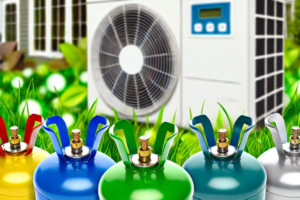Refrigerant Options in HVAC Systems: A Homeowner’s Guide
 One key component of your HVAC system is the refrigerant – the substance responsible for cooling your home. Over the years, refrigerants have evolved, with new options emerging to meet environmental and efficiency standards. As a homeowner, understanding these refrigerant options can help you make informed decisions about your HVAC system. This guide will walk you through the various refrigerant options, their benefits, and what you need to know to keep your home comfortable and eco-friendly.
One key component of your HVAC system is the refrigerant – the substance responsible for cooling your home. Over the years, refrigerants have evolved, with new options emerging to meet environmental and efficiency standards. As a homeowner, understanding these refrigerant options can help you make informed decisions about your HVAC system. This guide will walk you through the various refrigerant options, their benefits, and what you need to know to keep your home comfortable and eco-friendly.
What is Refrigerant and Why Does it Matter?
Refrigerant is a chemical compound used in air conditioners and heat pumps to absorb and release heat, allowing your HVAC system to cool or heat your home effectively. The type of refrigerant your system uses can impact its efficiency, environmental footprint, and performance.
Traditional Refrigerants: R-22 (Freon)
For many years, R-22, commonly known as Freon, was the standard refrigerant used in residential HVAC systems. While effective, R-22 is a hydrochlorofluorocarbon (HCFC), which means it contributes to ozone depletion and has a high global warming potential (GWP). Due to these environmental concerns, the production and import of R-22 were phased out in the United States on January 1, 2020. While existing systems using R-22 can still be serviced, the refrigerant is becoming increasingly expensive and harder to find.
Modern Refrigerants: R-410A (Puron)
R-410A, also known by the brand name Puron, has become the new standard for residential HVAC systems. Unlike R-22, R-410A is a hydrofluorocarbon (HFC) that does not deplete the ozone layer. It also has better energy efficiency, allowing HVAC systems to operate more effectively and reduce energy costs.
Benefits of R-410A:
- Environmental Friendliness: R-410A has no ozone depletion potential (ODP).
- Energy Efficiency: Systems using R-410A are typically more efficient, leading to lower energy bills.
- Performance: R-410A operates at higher pressures, which can improve the overall performance of the HVAC system.
Emerging Refrigerants: R-32 and R-454B
As the HVAC industry continues to evolve, new refrigerants are being developed to meet even stricter environmental regulations and efficiency standards. Two notable emerging refrigerants are R-32 and R-454B.
R-32
R-32 is a single-component refrigerant with a lower GWP than R-410A. It is already widely used in Europe and Asia and is gaining popularity in the United States.
Benefits of R-32:
Lower GWP: R-32 has a GWP of 675, which is significantly lower than R-410A’s GWP of 2,088.
Efficiency: R-32 is highly efficient, requiring less refrigerant volume per system, which can reduce operating costs.
Safety: While slightly flammable, R-32 is safe when used in properly designed systems.
R-454B
R-454B is a new refrigerant blend designed to replace R-410A in residential and light commercial HVAC systems. It offers similar performance to R-410A but with a much lower GWP.
Benefits of R-454B:
Lower GWP: R-454B has a GWP of 466, making it one of the most environmentally friendly options available.
Efficiency: R-454B provides similar energy efficiency to R-410A, ensuring effective cooling and heating.
Ease of Transition: R-454B can be used in existing R-410A systems with minimal modifications.
What Does This Mean for Homeowners?
As a homeowner, you don’t need to become an expert in refrigerants, but understanding your options can help you make better decisions for your home and the environment. Here are a few practical steps you can take:
- Know Your System: Check which refrigerant your current HVAC system uses. If you have an older system that uses R-22, consider upgrading to a newer model that uses R-410A or another environmentally friendly refrigerant.
- Plan for the Future: If you’re in the market for a new HVAC system, look for models that use R-410A, R-32, or R-454B. These options will ensure better efficiency and lower environmental impact.
- Regular Maintenance: Proper maintenance of your HVAC system can improve its efficiency and extend its lifespan, regardless of the refrigerant used. Schedule regular check-ups with a professional to keep your system in top shape.
- Consult a Professional: When in doubt, consult an HVAC professional. They can provide guidance on the best refrigerant options for your specific needs and help you navigate any regulatory changes.
Conclusion
Refrigerants are a vital part of your HVAC system, and the options available today offer significant benefits in terms of efficiency and environmental impact. By understanding these options, you can make informed decisions that not only improve the comfort of your home but also contribute to a healthier planet. Whether you’re upgrading your current system or exploring new installations, choosing the right refrigerant is an important step toward a more sustainable future.
Remember, the key to a comfortable and efficient home is not just the refrigerant but the entire HVAC system. Regular maintenance, proper installation, and professional guidance will ensure your home remains a haven of comfort, no matter the weather outside.

 Jacobs and Rhodes
Jacobs and Rhodes Jacobs and Rhodes
Jacobs and Rhodes